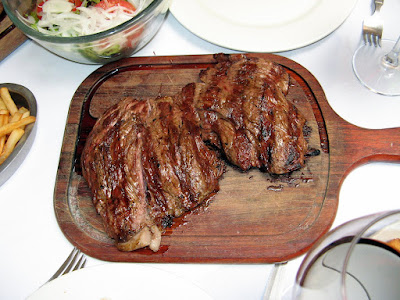 |
| Plaza Luis Cabrera, Colonia Roma Norte |
That non-event left us with two vouchers for tickets on the AutoVías bus lines. Moreover, an old friend in Mexico City had just acquired a new Apple iMac Computer, and asked for tips in making her conversion from Windows P.C.'s. I was very pleased to help.
We arrived Friday, and took the fast Metro ride from Metro Observatorio (just across from the Observatorio Bus Station", and a few minutes later, were looking for the correct exit for Calle Jalapa in the sunken gladiatorial glorieta ring at Metro Insurgentes.)
Our hotel was the perennial Milán, on Av. Álvaro Obregón. Nice place; modern, clean and very nicely situated in one of the pleasantest areas of the city.
After checking in, we headed out for grilled hamburgers at the now famous Hamburgesas a la Parrilla stand in Colonia Roma Norte, Mexico City. They were good but not as searingly memorable as on previous occasions, as trade was light and the hamburgers were parcooked when we ordered. Still, the 3 of us managed to eat 5 in all.
Sunday afternoon in Mexico City, our old friend and her 20+ y/o daughter invited us to dine at Parrilla Quilmes, one of many choice Argentine restaurants in Colonia La Condesa. We further satisfied our carnivore lusts with two orders meant for two persons; one of "vacío", a hanger steak like cut; and "bife de lomo", a more compactly grained slab of beef. Both served on wooden cutting boards. Chimichurrí and a picante red sauce, and a bottle of o.k-but-not-great mustard sauce to be added al gusto. We shared a boat of crisp brown papas Francesas and a bowl of salad.
 |
| Parrilla Quilmes |
 |
| Vacío |
 |
| Empanadas at Parrilla Quilmes |
The distinctive Veracruzana treatment of seafood is famous in Mexico. I started with a bowl of Chilpachole de Jaiba, a spicy crab soup, loaded with crabmeat, already picked from the shell.
 |
| La Embajada Jarocha building |
It was filling, and she couldn't quite finish her second course of three tostadas with different types of hot (!) seafood on each. However, the saucing and spicing were identical on all, so interest palled after a few bites. Still, not bad, if somewhat over salted (as were the two soups.)
I forged ahead with a filete de mero (grouper) al acuyo (cooked in a leaf of Hoja Santa or Piper Auritum), wrapped in aluminum oil and steamed. It was light and clean, yet savory and very good, especially after the spicy soups.
 |
| Filete de pescado al acuyo |
There was other food, of course, over the weekend, but those three places were the memorable highlights. Breakfasts were usually at Bisquets, Bisquets, Obregón, at la Mamá de Todos Bisquets. Moderate priced, nice Mexican family fare, brisk service; plus, they give a discount to viejos who carry an INAPAM credencial. The specialties are the house-made pan dulce and the café con leche, served with style, from two metal kettles, with the milk poured from on high.
(Oddly, with such good pan dulce, why is the bread in the baskets so corriente?)
Next to the Hotel Milán is Café Fertíl, a Fair Trade coffehouse serving o.k. breakfasts and terrific coffee. We also enjoyed a couple of soda fountain treats at La Bella Italia, on Calle Orizaba, after a visit to the Circo Atayde Hermanos, which is another story, but one nicely described on Mexico Cooks! and David Lida's blog. I won't elaborate on it here, except that we really enjoyed the show. (I, for one, was shocked, SHOCKED, I tell you, by the scantily clad and lovely female dancers. Mmmm.)
We took an ETN bus home as far as Morelia. We really need to use ETN more often, as it's quite a bit more comfortable than AutoVías, our usual choice, and the included sandwiches weren't too bad. There's also hot water, of a sort, for tea and instant coffee, which you must ask for when you board.
At Morelia, we got a second-class, Purépechas bus, which dropped us off at the intersection of our choice. Second class buses give you opportunities to buy snacks and other stuff from vendors who come on board, but we did not.





